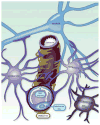Overview and introduction: the blood-brain barrier in health and disease
- PMID: 23134489
- PMCID: PMC3625728
- DOI: 10.1111/j.1528-1167.2012.03696.x
Overview and introduction: the blood-brain barrier in health and disease
Abstract
This article introduces the special issue on "Blood-Brain Barrier and Epilepsy." We review briefly current understanding of the structure and function of the blood-brain barrier (BBB), including its development and normal physiology, and ways in which it can be affected in pathology. The BBB formed by the endothelium of cerebral blood vessels is one of three main barrier sites protecting the central nervous system (CNS). The barrier is not a rigid structure, but a dynamic interface with a range of interrelated functions, resulting from extremely effective tight junctions, transendothelial transport systems, enzymes, and regulation of leukocyte permeation, which thereby generates the physical, transport, enzymatic, and immune regulatory functions of the BBB. The brain endothelial cells are important components of a "modular" structure, the neurovascular unit (NVU), with several associated cell types and extracellular matrix components. Modern methods have helped in identifying a range of proteins involved in barrier structure and function, and recent studies have revealed important stages, cell types, and signaling pathways important in BBB development. There is a growing list of CNS pathologies showing BBB dysfunction, with strong evidence that this can play a major role in certain disease etiologies. The articles that follow in this issue summarize in more detail reports and discussions of the recent international meeting on "BBB in Neurological Dysfunctions," which took place recently at Ben-Gurion University of the Negev Desert Campus (Beer-Sheva, Israel), focusing on the link between experimental and clinical studies, and the ways in which these lead to improved drug treatments.
Wiley Periodicals, Inc. © 2012 International League Against Epilepsy.
Conflict of interest statement
The authors have no conflicts of interest to disclose. We confirm that we have read the Journal’s position on issues involved in ethical publication and affirm that this report is consistent with those guidelines.
Figures
References
-
- Aänismaa P, Gatlik-Landwojtowicz E, Seelig A. P-glycoprotein senses its substrates and the lateral membrane packing density: consequences for the catalytic cycle. Biochemistry. 2008;47:10197–10207. - PubMed
-
- Abbott NJ. Evidence for bulk flow of brain interstitial fluid: significance for physiology and pathology. Neurochem Int. 2004;45:545–552. - PubMed
-
- Abbott NJ, Rönnbäck L, Hansson E. Astrocyte-endothelial interactions at the blood-brain barrier. Nat Rev Neurosci. 2006;7:41–53. - PubMed
-
- Abbott NJ, Patabendige AA, Dolman DE, Yusof SR, Begley DJ. Structure and function of the blood-brain barrier. Neurobiol Dis. 2009;37:13–25. - PubMed
-
- Alvarez JI, Dodelet-Devillers A, Kebir H, Ifergan I, Fabre PJ, Terouz S, Sabbagh M, Wosik K, Bourbonnière L, Bernard M, van Horssen J, de Vries HE, Charron F, Prat A. The Hedgehog pathway promotes blood-brain barrier integrity and CNS immune quiescence. Science. 2011;334:1727–1731. - PubMed
Publication types
MeSH terms
Grants and funding
LinkOut - more resources
Full Text Sources
Other Literature Sources
Medical


